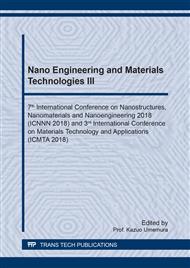p.109
p.114
p.119
p.125
p.130
p.137
p.142
p.148
p.155
Thermoelectric Cell Produced from AA1100 Aluminium Alloy Coating on Metakaolin by Friction Surfacing Process
Abstract:
The objective of this article was to demonstrate the alternative method to produce the metal electrode on ceramic substrate. AA1100 aluminium alloy was thin-coated on alumina substrate by friction surfacing using a CNC milling machine. The properties of the coating layer were presented. After that, the coated ceramic substrate was connected to a thermoelectric material and used as thermoelectric electrode of the thermoelectric cell. Voltage, differential temperature and electrical current were measured. Power and efficiency of the thermoelectric cell were calculated. The maximum temperature at hot side of the thermoelectric cell was 171.48 °C. At this temperature, the voltage was 0.00027 mV and the power was 0.000655 W. Efficiency of the fabricated thermoelectric cell was 4.715 x 10-7.
Info:
Periodical:
Pages:
130-134
Citation:
Online since:
March 2019
Keywords:
Price:
Сopyright:
© 2019 Trans Tech Publications Ltd. All Rights Reserved
Share:
Citation:


